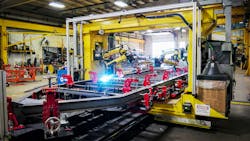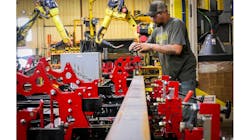Felling Trailers, a family-owned, full-line manufacturer in Sauk Centre MN, recently acquired a two-cell gantry robot with Fanuc R-100iC robotic arms in an effort to reduce lead times by increasing production capabilities and efficiencies.
“Our goal with adding the two-cell gantry robot is to provide a consistently high-quality product while reducing production lead times,” said Paul Radjenovich, vice president of operations for Felling.
The system isn’t Felling’s first robotic welding system, either.
The new Gantry robot is one of several robots put into service over the years, Felling said. In early 2000, the company purchased its first robotic welding system, an OTC DAIHEN robotic welding cell. The OTC was utilized to produce a variety of ramps for Felling’s 90-plus ramp trailer models. Then, in 2010, the company purchased a Genesis robotic welder it utilizes in the production of ramps, dump trailer doors and other trailer components. With the recent addition of the two-cell gantry robot, Felling says it can weld a trailer to “frame level,” hitch to tail, including cross members, frame rails, headboard and tailboard.
The gantry robot’s operations team consists of a production operator, CWI weld trainer, fixture designer and a maintenance technician. The weld trainer and fixture designer work together to layout the fixtures needed for trailer builds and the programming, Felling said. The production operator’s role is to place trailer components into the fixture and verify tolerances before the robot starts its work. The robot’s objective then is to weld the trailer to its frame level. While the robot is welding the frame, the operator monitors the welding process while staging the next fixture to run through the gantry robot program.
Overall, the frame-level weld production process is completed roughly 30% faster than a manual process. With the frame-level weld complete, the trailer moves on to an assigned weld team to add axles, tie-downs and other customer-specific weld-on options.
To date, the two-cell gantry robot has completed 150 units consisting of two of Felling’s most popular model lines, and as more lines are added, new fixtures will be designed, and programming written, Felling added.
“The continuous addition of fixtures will help develop multiple teams to work together and advance their training,” said Chris Berg, project manager.
Along with adding more model lines to the gantry robot’s database, Felling said it also plans to add trailer components such as beavertails to maximize productivity based on product demand.
“We have seen significant growth over the last several years, and with that comes the need to increase manufacturing capacity to meet market demands for our product,” Radjenovich said.
The addition of the two-cell gantry robot has created a new step in the production cycle of trailers, Felling concluded. The increased production capabilities have, in turn, created additional jobs on the front end of the build cycle for engineers, fixture designers, fabricators and material handlers to feed the robot. Then, on the backside of the production cycle—once the robot has completed the trailer to frame level—the weld teams can complete the weld production cycle, bringing the process full circle.

